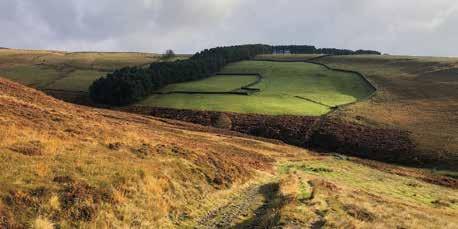
9 minute read
NEWS
ACID
Archaeology and Conservation in Derbyshire and the Peak District ISSUE 17 JANUARY 2020
Finding my Mesolithic granny!
Young Archaeologists’ Club
Inside:
Alice through the Looking Glass The hidden history of hoards
Our year in numbers: planning and heritage statistics
2020 | ACID 1
Have you read ACID?
Young Peak District archaeologist Kit Bailey features on the cover of this year’s Archaeology and Conservation in Derbyshire and the Peak District ‘ACID’ magazine, describing inside why he finds archaeology and history so exciting. Another highlight is the biological anthropologist and TV presenter Alice Roberts talking about her career, from her medical training through to her eminent academic position as Professor of Public Engagement in Science at the University of Birmingham. Her words about humans and nature may ring true for many of us.
Read about Andy Bentham’s fascinating research into graffiti and protective apotropaic marks, sometimes known as ‘witch’ marks; Buxton Museum’s summer exhibition of artefacts from the British Museum’s touring exhibition Hoards: A Hidden History of Ancient Briton alongside specially-commissioned photographs by Derbyshire photographer Nick Lockett; as well as Bronze Age burials and 20th century Prisoner of War camps.
ACID showcases archaeological and conservation projects that have taken place in the Peak District National Park, and wider Derbyshire, over the last 18 months. It is produced jointly by the Peak District National Park Authority and Derbyshire County Council on behalf of the Derbyshire Archaeological Advisory Committee. You can read ACID online at www.peakdistrict.gov.uk/acid-magazine For more information about the Peak District Young Archaeologist Club visit www.yac-uk.org/clubs/peak-district
Cracking archaeology at Cracken Edge
MA Landscape Archaeology student Elin Price has been looking at Cracken Edge Quarry, Chinley, whilst on placement with the Peak District National Park Authority. Elin’s level 1 archaeological survey recorded the topography, location, type, measurements and condition of features at the hillside site. A desk-based assessment examined relevant historic material including maps and previous research. Cracken Edge is a dramatic scarpedge quarry, and a Regionally Important Geological Site (RIGS). It specialised in the production of flags and slates for paving and roofing. Existing since at least the 1600s, when local shareholders held ownership, by 1800 Cracken was a substantial enterprise employing many local men. The survey identified 59 features including structures, adits and machinery, highlighting the once industrious nature of this interesting site, which is now a popular place for a walk.

North West boundary walk No.2 setting off from Longdendale Environmental Centre. View of Ogden Clough in the distance. PHOTO: CORA GLASSER 2019

A story of a boundary
GUIDEline is a project being delivered by artists from Glassball over the next two years, exploring the nature and origins of the first National Park and its boundary. Last year marked 70 years since an Act of Parliament established National Parks. The formation of the Peak District’s boundary will frame innovative creative engagement opportunities, for residents and visitors alike, to discover and share personal responses to an emerging story at a key point in the National Park’s history. Through collaborative research and co-creating artworks, the significance of a boundary will be discussed and understood: what does it mean to live within a mark on a map from 70 years ago and how does this administrative construct manifest itself in everyday life? For information about up and coming free events and activities over the next two years, visit www.guideline.org.uk GUIDEline is funded by the National Lottery Heritage Fund, Arts Council England and is supported by the Peak District National Park Authority.
A new leaf

Seen at our Bakewell HQ with the new Nissan Leaf EV vehicle (l-r) Prof. Janet Haddock-Fraser (member, climate change working group), Sarah Fowler (CEO) and Andrew McCloy (chair).
If you’re out and about enjoying the Peak District this spring and summer, you might just see a bold new addition to the National Park Authority vehicle fleet.
Joining others in the UK national parks family, we have welcomed the first of what it’s hoped will be many electric or ‘EV’ vehicles to our fleet.
With a range of between 150-200 miles on a single charge, the new Nissan Leaf (based at our Bakewell HQ) will be able to undertake trips across the Peak District – but crucially without adding to emissions and air pollution in the National Park. Adapting our vehicle fleet is a core task as part of the Authority’s carbon management strategy, which is about to enter a second phase after significant strides forward in recent years which have led to a drop of almost 30% in our operational carbon footprint.
Another recent move with our fleet vehicles was to move away from former diesel pool cars to a number of more efficient and cleaner petrol vehicles in 2018. We now expect to take on EV replacements for many of these vehicles as they are replenished in the coming years. Charging points for EV vehicles remain a challenge in the largely rural landscape of the National Park, but we are working closely with businesses and universities to understand the practicalities of installing this infrastructure and where it can deliver the most benefit. The push for EV charging points in the National Park has also received the support of High Peak MP Sarah Dines, who has also pressed the Chancellor for funding to progress the infrastructure required.
Online meeting technology, encouraging car sharing and other measures are all helping us to head towards a ‘net carbon zero’ target, which is also being embraced across many of our constituent counties such as Derbyshire. From regional climate summits, to smallscale village and community approaches such as that discussed in villages including Over Haddon, residents and visitors are coming together to share ideas and innovation.
Alongside practical measures within our own operations, the Authority has also been working to encourage an increase in public transport options for our visitors, resulting in an extended 2020 A new livery reflects the eco-credentials of our EV vehicle.

season for the ‘Hope Valley Explorer’ bus service (more on page 28). Not only does the Explorer reduce private car journeys in some of our busiest and most popular areas, but it also provides a key ‘final mile’ link for those already travelling sustainably by train and arriving at Bamford, Hope or Edale.
To understand more about the action the National Park Authority is taking on climate change and how this can be applied in your community, visit www.peakdistrict.gov.uk
Regular visitors to the Monsal Trail will have seen the transformation of the former Goods Shed continue throughout the winter, despite some challenging weather conditions! The most significant change has been the continuing construction of a new roof on the Goods Shed, a dramatic mix of trusses and beams that also bring a touch of the 21st century in the shape of their glue-lam production technique. Around the rest of Goods Shed, the painstaking job of pointing the blockwork carries on, in readiness to receive a new set of imposing wooden doors on two sides of the building in the coming weeks.
To coincide with the renovation, local charity Accessible Derbyshire have also launched their ‘202020’ campaign in a bid to secure a Changing Place at the Goods Shed, expected to cost around £20,000. This would be only the second of these specialist facilities to be based in the National Park, which provide washroom and hoist movement options for adults, as well as young people and children. If you want to know more about the campaign, would like to become a 202020 sponsor or to learn more about Changing Places, please contact Accessible Derbyshire on accessiblederbyshire@gmail.com
The Goods Shed will open to visitors during summer 2020, including an exciting interpretation and information zone, sharing the Millers Dale story throughout the generations.
Raptor review for 2019

Fledging goshawks from eight nests, the return of hen harriers for another consecutive year and a reduction in reported wildlife crime incidents all framed the 2019 breeding season for birds of prey (or raptors) in the Peak District uplands.
The Peak District Bird of Prey Initiative – which monitors several key raptor species in a study area across the Dark Peak – also reported over 40 fledged young from nests of both merlin and short-eared owl, although nesting territory numbers continue to remain unstable.
The peregrine falcon continues to be a species at risk in the study area, with just three nests producing young. However, welcome news from elsewhere in the
Peak District was the return of the red kite, the first
confirmed breeding for over 150 years.
Find the full report at www.peakdistrict.gov.uk
Red kite. Peregrine falcon.
All eyes on peregrines

One of the most iconic wildlife species in the Peak District will be the focus of a new campaign of protection this spring. Peregrine falcons – widely recognised as the fastest animal in the world – have been subject to an increase in disturbance at their nest sites in the White Peak in recent years.
Work by a number of groups, including the police, has identified the theft of eggs and even young peregrine chicks to support the overseas falconry trade behind this illegal activity. This is despite the birds regularly using disused quarries where nests are often in inaccessible locations.
Several nests fell victim during the 2019 breeding season, affecting the overall population of the peregrines in the National Park. This spring and summer will see volunteers, wildlife professionals and police Rural Crime Teams come together in an enhanced programme of breeding site surveillance.
The public are also being asked to provide an extra pair of eyes and ears with police encouraging anyone witnessing suspicious activity to report on 101 quoting ‘Operation Spotswood’.
If you believe you are observing a wildlife crime taking place at the time, please call 999. Non-urgent information can also be shared direct to the Derbyshire police Rural Crime Team on DRCT@derbyshire.police.uk or through their Facebook page.
Calling on well dressing groups to make 2020 the year of the bumble bee for the Peak District
The Bumblebee Conservation Trust is asking well dressing groups to help it protect bumblebees and to raise awareness about a rare local species. The bilberry bumblebee lives on the Peak District’s upland moors and feeds on the heather and bilberry. Sally Cuckney, project manager of Pollinating the Peak at the Bumblebee Conservation Trust, said: “We would love to get as many villages as possible to pick bumblebees as their well dressing theme for 2020 and help make the Peak District a haven for bumblebees.
“If you choose a bumblebee theme, we could visit your group and give a free talk about the importance of bumblebees and what the Bumblebee Conservation Trust is doing to help protect the local treasure of the Bilberry Bumblebee in the Peak District.” Bilberry bumblebee.











